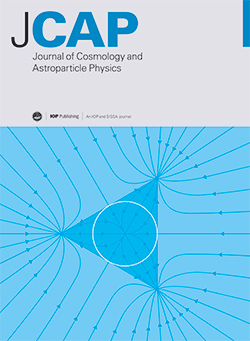Kick it like DESI: PNGB quintessence with a dynamically generated initial velocity
IF 5.3
2区 物理与天体物理
Q1 ASTRONOMY & ASTROPHYSICS
Journal of Cosmology and Astroparticle Physics
Pub Date : 2025-03-07
DOI:10.1088/1475-7516/2025/03/015
引用次数: 0
Abstract
Motivated by the hint for time-dependent dynamical dark energy from an analysis of the DESI Baryon Accoustic Oscillation (BAO) data together with information from the Cosmic Microwave Background (CMB) and Supernovae (SN), we relax the assumption of a vanishing initial velocity for a quintessence field. In particular we focus on pseudo-Nambu-Goldstone-Boson (PNGB) quintessence in the form of an axion like particle, that can arise as the phase of a complex scalar and could possess derivative couplings to fermions or topological couplings to abelian gauge fields, without upsetting the necessary flatness of its potential. We discuss mechanisms from the aforementioned interactions for sourcing an initial axion field velocity θ̇i at redshifts 3 ≤ z ≤ 10, that will “kick” it into motion. Driven by this initial velocity the axion will first roll up in its potential, similar to “freezing” dark energy. After it has reached the pinnacle of its trajectory, it will start to roll down, and behave as “thawing” quintessence. As a proof of concept we undertake a combined fit to BAO, SN and CMB data at the background level. We find that a scenario with θ̇i = 𝒪(1) ma, where ma is the axion mass, is slightly preferred over both ΛCDM and the conventional “thawing” quintessence with θ̇i = 0. The best fit points for this case exhibit transplanckian decay constants and very flat potentials, which both are in tension with conjectures from string theory.求助全文
约1分钟内获得全文
求助全文
来源期刊

Journal of Cosmology and Astroparticle Physics
地学天文-天文与天体物理
CiteScore
10.20
自引率
23.40%
发文量
632
审稿时长
1 months
期刊介绍:
Journal of Cosmology and Astroparticle Physics (JCAP) encompasses theoretical, observational and experimental areas as well as computation and simulation. The journal covers the latest developments in the theory of all fundamental interactions and their cosmological implications (e.g. M-theory and cosmology, brane cosmology). JCAP''s coverage also includes topics such as formation, dynamics and clustering of galaxies, pre-galactic star formation, x-ray astronomy, radio astronomy, gravitational lensing, active galactic nuclei, intergalactic and interstellar matter.
 求助内容:
求助内容: 应助结果提醒方式:
应助结果提醒方式:


